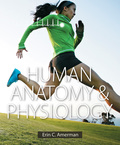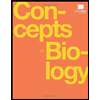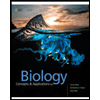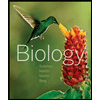
EBK HUMAN ANATOMY & PHYSIOLOGY
16th Edition
ISBN: 8220100659836
Author: AMERMAN
Publisher: PEARSON
expand_more
expand_more
format_list_bulleted
Concept explainers
Textbook Question
Chapter 2.5, Problem 2QC
2.3. How do monosaccharides, disaccharides, and polysaccharides differ?
Expert Solution & Answer
Trending nowThis is a popular solution!

Students have asked these similar questions
For each response, you must first state whether you are accepting or rejecting that statement. Then,you must write a detailed explanation why you accept or reject each of the choices.PROBLEM:
After playing beach volleyball on a hot summer day, Sam is sweating hard and feeling very thirsty. Afriend suggests drinking some beer to help his body replace the fluids it has lost. Which one of thefollowing statements contains the most logical and accurate response?A. Great idea! In addition to the fluid, the beer will replenish nutrients he's used up.B. Good idea! Not only will the beer replenish the fluids, but it will help remove excess salts that haveaccumulated.C. No way! Although the beer will replenish the fluids, it will cause removal of important solutes fromthe kidneys.D. No way! The beer will only intensify the problem of dehydration by suppressing ADH.E. No way! The beer may help replenish the fluids, but it will merely make him sweat even more
For each response, you must first state whether you are accepting or rejecting that statement. Then,you must write a detailed explanation why you accept or reject each of the choices.PROBLEM:
After playing beach volleyball on a hot summer day, Sam is sweating hard and feeling very thirsty. Afriend suggests drinking some beer to help his body replace the fluids it has lost. Which one of thefollowing statements contains the most logical and accurate response?
D. No way! The beer will only intensify the problem of dehydration by suppressing ADH.
This practice question is from the textbook "Genetics: From Genes to Genomes". It is chapter 13, question 9.
a. Which two of the breakpoints could yield a deletion?
b. Write the sequence and polarity of a 16-base primer that, in conjunction with primer A, will allow you to diagnose the presence of a deletion in a patient’s genomic DNA. The evidence should be positive, not negative. (That is, you will see a PCR product whose presence and/or size is specific to the deletion; the absence of a band is not informative.)
c. Which two of the breakpoints could yield an inversion?
d. Write the sequence and polarity of a 16-base primer that, in conjunction with primer A, will allow you to diagnose the presence of an inversion in a patient’s genomic DNA. Your answer should show the primer that would yield the longest possible diagnostic PCR product. Your primer cannot cross any of the red lines.
e. Which two of the breakpoints could yield a reciprocal translocation? (Two possible answers exist;…
Chapter 2 Solutions
EBK HUMAN ANATOMY & PHYSIOLOGY
Ch. 2.1 - Prob. 1QCCh. 2.1 - What are atoms?Ch. 2.1 - How do the three types of subatomic particles...Ch. 2.1 - What is an element?Ch. 2.1 - 4. How are elements arranged in the periodic...Ch. 2.1 - What are isotopes?Ch. 2.1 - Prob. 1AWYLCh. 2.1 - The element lithium has an atomic number of 3 and...Ch. 2.2 - What is a mixture?Ch. 2.2 - 2. How do the three types of mixtures differ?
Ch. 2.2 - Prob. 3QCCh. 2.2 - What is an ionic bond?Ch. 2.2 - 5. How is an ionic bond formed?
Ch. 2.2 - 6. Explain how polar and nonpolar covalent bonds...Ch. 2.2 - What are hydrogen bonds? Why do hydrogen bonds...Ch. 2.2 - Which would be more reactive-an atom of fluorine...Ch. 2.2 - Would a molecule of hydrogen (H2) form hydrogen...Ch. 2.2 - Explain why the molecule Na2 does not exist in...Ch. 2.3 - Prob. 1QCCh. 2.3 - Prob. 2QCCh. 2.3 - How do endergonic and exergonic reactions differ?Ch. 2.3 - Prob. 4QCCh. 2.3 - What factors can influence the rate of a chemical...Ch. 2.3 - 6. What is an enzyme, and what does an enzyme do?
Ch. 2.3 - Prob. 1AWYLCh. 2.3 - Explain why most biological molecules are stable...Ch. 2.3 - 3. Many naturally occurring poisons function by...Ch. 2.4 - What are four properties of water that make it a...Ch. 2.4 - 2. Which molecules are likely to be hydrophilic?...Ch. 2.4 - 3. Define the terms acid and base.
Ch. 2.4 - What is the pH scale? Which pH values are...Ch. 2.4 - What is the effect of a buffer on a solution?Ch. 2.4 - What is a salt?Ch. 2.4 - 7. What does an electrolyte do in a solution?
Ch. 2.4 - Explain how the water surrounding a fetus in the...Ch. 2.4 - Prob. 2AWYLCh. 2.5 - 1. How do polymers and monomers differ?
Ch. 2.5 - 2.3. How do monosaccharides, disaccharides, and...Ch. 2.5 - 2. How do monosaccharides, disaccharides, and...Ch. 2.5 - How are two monosaccharides linked to form a...Ch. 2.5 - Prob. 5QCCh. 2.5 - 5. How do phospholipids and triglycerides differ?
Ch. 2.5 - What are steroids?Ch. 2.5 - Prob. 8QCCh. 2.5 - How are amino acids linked to form peptides and...Ch. 2.5 - What are the four levels of structural...Ch. 2.5 - 10. What are the components and roles of ATP?
Ch. 2.5 - 11. How do DNA and RNA differ?
Ch. 2.5 - 11. What are the three components of a...Ch. 2.5 - Which molecule would be the most soluble in water:...Ch. 2.5 - In Module 2.3, you learned that increasing...Ch. 2.5 - 3. How could a defect in a gene lead to a...Ch. 2 - Prob. 1CYRCh. 2 - Fill in the blanks: Isotopes are atoms with the...Ch. 2 - 3. Which of the following statements correctly...Ch. 2 - 4. Explain the difference between an ionic and a...Ch. 2 - Identify each of the following molecules or...Ch. 2 - What are hydrogen bonds, and how do they form?Ch. 2 - Prob. 7CYRCh. 2 - Prob. 8CYRCh. 2 - Which of the following would not result in an...Ch. 2 - 10. An enzyme is a:
a. biological catalyst that...Ch. 2 - Prob. 11CYRCh. 2 - With respect to their solubility in water,...Ch. 2 - Mark the following statements as true or false. If...Ch. 2 - A salt is: a. a metal cation bonded to a nonmetal...Ch. 2 - 15. Compare and contrast the structures of...Ch. 2 - 16. Mark the following statements as true or...Ch. 2 - 17. Why is it important for a protein to maintain...Ch. 2 - Which of the following is not part of a...Ch. 2 - 19. Mark the following properties as belonging to...Ch. 2 - Which of the following statements is/are true...Ch. 2 - 1. In certain types of radioactive decay, the...Ch. 2 - Considering that water is a main component of the...Ch. 2 - 3. Explain why monosaccharides are polar and fatty...Ch. 2 - 1. The polysaccharide cellulose is not digestible...Ch. 2 - Some claim that the pH of your blood can be...Ch. 2 - Prob. 3AYKCh. 2 - Prob. 5AYKCh. 2 - You have just dropped some phospholipids into...
Knowledge Booster
Learn more about
Need a deep-dive on the concept behind this application? Look no further. Learn more about this topic, biology and related others by exploring similar questions and additional content below.Similar questions
- MyoD is a transcriptional factor that acts specifically in muscle cells. It is hypothesized that Id proteins indirectly repress the transcription of muscle-specific proteins by inhibiting the function of MyoD. Which of the following are mechanisms by which Id proteins act as indirect repressors? (choose all that applies) Compete with activators for access to an enhancer. Bind the activation domain of an activator bound to an enhancer. Bind to activators and hold them in the cytoplasm. Form heterodimers with activators and lessen the homodimers of activators. Please explain each answer choice please.arrow_forwardWeek 4 Rodney Balbo's Imaging servicearrow_forward"Which of the following about transposable elements (TEs) is false?" RNA transposons move using an RNA intermediate. DNA transposons make up 3% of the human genome but are disruptive. Genes can move within the same chromosome via TEs. The Drosophila P element can only move in germline cells. Can you explain each answer choices pleae?arrow_forward
- What will control the rate of bioremediation of petroleum? (Choose all correct answers) The availability of the petroleum The temperature of the water The availability of oxygen The percent of the population that has degraded petroleum in the pastarrow_forwardWhich of the following would lead to a false negative result in a sandwich ELISA (the lab manual refers to this as a direct ELISA- also known as search for antigen)? Mark all correct answers. antibody was non-specific and bound to something other than the antigen of interest. too short of a duration when incubating the reagents in the plate. If there are multiple strains of the pathogen of interest and the antibody does not recognize one of the strains. Did not sample the correct bodily fluid/area to detect the antigen concentration of antigen was too low to detect in the patient sample. inadequate washing was performed after the enzyme linked antibody was allowed to bind. substrate was exposed to too much light reusing a pipette that was used to pipette a positive sample.arrow_forwardS. +1269 pts /1500 © Macmillan Learning 0 Resources Solution Penalized Feedback Try Again Draw the final product with stereochemistry and lone pairs. The leaving group has been pre-drawn for your convenience. +100 +100 : 0: + H,C- :0: : 0 0 : +100 +94 possible ✓ +100 K Attemparrow_forward
- +1269 pts /1500 © Macmillan Learning t/1188d950-dd73-11e0-9572-0800200c9a66/3045511b-267e-4a00-86ca-85dbc62ecb4e/6ac3a0c9-... a □ 出 All Bookmarks Due: Mon, May 26 Resources Solution Penalized Feedback Try Again KX Attempt 3 Draw the final product with stereochemistry and lone pairs. The leaving group has been pre-drawn for your convenience. :0: + нс H,C- :0: : 0:arrow_forwards. +1169 pts /1500 © Macmillan Learning 0 Resources Hint Submit Answer Step 3: This tertiary carbocation intermediate readily undergoes elimination with any weak base to form two possible products. + + H :0: H +94 possible 3a) Draw the minor organic product of elimination. Select Draw Templates More +100 +95 possible # C Major product + Minor product 3b) Draw the major organic product of elimination. Erase Select Draw Templates More C Erasearrow_forwardExplain the Science & Society on (with links and pictures): ---- Question down below Discuss the ethical, medical, and societal implications of using advanced genetic techniques?arrow_forward
- Explain the Disease Mechanism & Impact on (with links and pictures): What causes Leigh Syndrome and why it's so deadly. Which cellular functions, organelles (especially mitochondria), and macromolecules are involved.arrow_forwardExplain the Disease Mechanism & Impact on (with links and pictures): What's going wrong inside the cell and the effects on the human body. Describe metabolism with an emphasis on cellular respiration.arrow_forwardExplain the Disease Mechanism & Impact on (with links and pictures):arrow_forward
arrow_back_ios
SEE MORE QUESTIONS
arrow_forward_ios
Recommended textbooks for you
 Human Biology (MindTap Course List)BiologyISBN:9781305112100Author:Cecie Starr, Beverly McMillanPublisher:Cengage Learning
Human Biology (MindTap Course List)BiologyISBN:9781305112100Author:Cecie Starr, Beverly McMillanPublisher:Cengage Learning Concepts of BiologyBiologyISBN:9781938168116Author:Samantha Fowler, Rebecca Roush, James WisePublisher:OpenStax College
Concepts of BiologyBiologyISBN:9781938168116Author:Samantha Fowler, Rebecca Roush, James WisePublisher:OpenStax College Lifetime Physical Fitness & WellnessHealth & NutritionISBN:9781337677509Author:HOEGERPublisher:Cengage
Lifetime Physical Fitness & WellnessHealth & NutritionISBN:9781337677509Author:HOEGERPublisher:Cengage Biology (MindTap Course List)BiologyISBN:9781337392938Author:Eldra Solomon, Charles Martin, Diana W. Martin, Linda R. BergPublisher:Cengage Learning
Biology (MindTap Course List)BiologyISBN:9781337392938Author:Eldra Solomon, Charles Martin, Diana W. Martin, Linda R. BergPublisher:Cengage Learning


Human Biology (MindTap Course List)
Biology
ISBN:9781305112100
Author:Cecie Starr, Beverly McMillan
Publisher:Cengage Learning

Concepts of Biology
Biology
ISBN:9781938168116
Author:Samantha Fowler, Rebecca Roush, James Wise
Publisher:OpenStax College


Lifetime Physical Fitness & Wellness
Health & Nutrition
ISBN:9781337677509
Author:HOEGER
Publisher:Cengage

Biology (MindTap Course List)
Biology
ISBN:9781337392938
Author:Eldra Solomon, Charles Martin, Diana W. Martin, Linda R. Berg
Publisher:Cengage Learning
Biomolecules - Protein - Amino acids; Author: Tutorials Point (India) Ltd.;https://www.youtube.com/watch?v=ySNVPDHJ0ek;License: Standard YouTube License, CC-BY